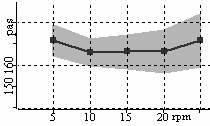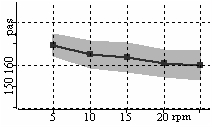Powders can behave very differently depending on the amount of energy they are subjected to as they move through handling equipment. One powder may flow more evenly as it is subjected to more mechanical energy while another powder may become more erratic. This behavior can be studied using the REVOLUTION Multi-Flow test method. In the multi-flow method, the sample drum speed is increased gradually over time and the sample powder's behavior is measured.
The Multi-Flow Analysis studies how a powder or granular material transitions from avalanching to continually flowing as it is subjected to faster speeds. By gradually increasing the rotation speed in the Multi-Flow Analysis, the user can evaluate the speed at which their powder is no longer avalanching in their process but flowing continuously. This data can be used to predict how powders will behave in high speed equipment.
| Before analysis, the samples are prepared by rotating the sample drum at a fixed speed for a fixed time. In this case, the preparation consisted of rotating the powder drum at 20 RPM for 30 seconds to aerate the sample. The prep time and rotation speed are user programmable and are selected to best suit the application being studied. |
Sample Preparation |
| After preparation, the sample drum rotation is started and sample properties are measured. After programmable intervals, the drum speed is increased by fixed intervals and changes in the sample properties are determined. |
Analysis |
The Energy Function Graph displays the energy level of the sample powder versus drum rotation rate. This data is used to calculate energy slopes. The gray area presents the standard deviation of the energy level. Figure A shows data for a sample that behaves more erratically as the rotation speed increases while Figure B shows data for a sample that's behavior improves.
|
Figure A - Energy Function Poor Sample Behavior |
Figure B - Energy Function Good Sample Behavior |

